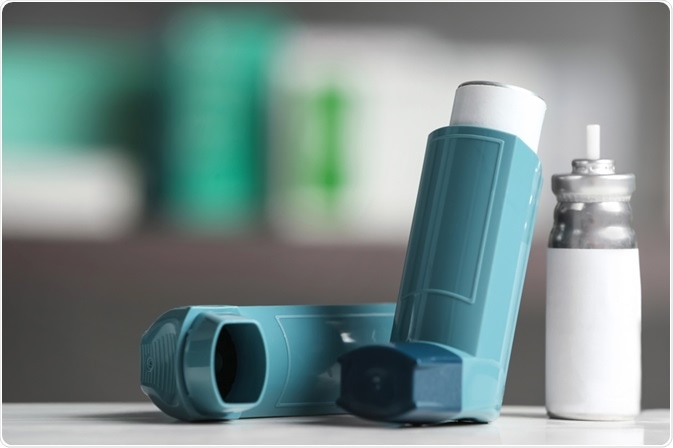Inhalers are used to treat chronic obstructive pulmonary disease (COPD), such as asthma, by delivering bronchodilator medication to the airway directly, without passing through the blood.

Image Credit: New Africa / Shutterstock.com
Why smart inhalers?
COPD affects over 200 million people the world over, and asthma another 300 million. Chronic respiratory disease makes up a little over 8% of the world’s chronic disease burden.
In order to mitigate the clinical severity of these conditions, patients need to adhere to a strict medication schedule, with the dosage and timing being adjusted to achieve control of their symptoms.
Inhalers are essential for observing the strict regimen required for these conditions, as they avoid the need for and the adverse effects associated with the use of injectables and oral drugs.
Nonetheless, many patients tend to misuse the freedom that comes with the use of inhalers by ignoring the recommended treatment schedule, failing to stock refills before the last one is empty,
However, the way medicine is being practiced has undergone dramatic changes with the development of novel technologies that help examine the health of the patient as a whole. This is particularly so with the Internet of Things (IoT).
Now that the internet has become a standard component of daily life, whether at home, the workplace or school, connectivity is the watchword for all kinds of technological processes. Such connectivity was earlier achieved by wireless (wi-fi) or Bluetooth networks, but now artificial intelligence (AI) is giving rise to new-generation medical devices that deliver smart care.
The inhaler is part of this transformation, with smart inhalers having emerged on the scene.
A smart inhaler is an inhaler that integrates connectivity with a mobile app, via Bluetooth, for instance. These devices are built with sensor technology that helps record data about the time and date of use, and the location of the patient at each use.
The world’s first smart inhaler to receive approval from the Food and Drug Administration (FDA) was Teva's ProAir Digihaler (albuterol sulfate), which has a use-tracking real-time sensor that syncs it to a mobile app.
The sensors may be either an integral part of the inhaler itself or be external devices that are attached to the primary inhaler. Several devices now being developed belong to the latter clip-on category, such as that from the United States-based company Propeller Health and New Zealand-based Adherium.
This can be used to set up an automatic reminder for the next dose. These inhalers help remind patients to use them at the right time, and can also alert the patients if they forget to take their devices with them. In addition, the issue of non-compliance could be addressed by these devices.
These records can provide data that predicts asthma attacks, thus allowing the patient to forestall them. This could help reduce the clinical severity and length of each such episode, preventing worsening of lung damage
The use of smart inhalers allows patients and their doctors to track their condition and monitor the efficacy of treatment in individual patients over time, without having to keep diaries or other written records.
The time and location tracking may also help identify trigger factors, share the data instantly with the doctor, and accumulate data for research. Some advanced models even sense high levels of air pollutants or pollen to warn patients of possible exacerbations.
Some tell if the patient has the right inhaler technique that delivers adequate amounts of the drug to the lungs and minimizes side effects. For instance, an Irish team developed an add-on that uses acoustic sensors to tell if the patient is using the inhaler correctly, concerning both the period of each inhalation or the technique.
Like inhalers themselves, smart inhalers are classified into pressurized or breath-actuated MDIs (metered-dose inhalers), DPIs (dry powder inhalers), and propellant-free multi-dose spray inhalers.
Astonishingly, up to 90% of the time, the patient inhaler technique is faulty, which reduces the amount of drug reaching the lungs by 60% to 93%. A short delay between inhalation and drug release can reduce the amount delivered by 80%, for instance. This prevents effective management and increases asthma severity, ultimately reflecting in inadequate cost management as well.
The medicine within inhalers uses lactose molecules and a fast, sharp inspiratory force is required to carry the medication into the airstream and lungs.
With the other types, a four-second-long steady deep inhalation is required, but most patients fail to do this.
Smart inhalers also acquire patient data relevant to their use. Such data would help identify faulty techniques and training and help correct these flaws, potentially with huge savings in terms of human suffering and financial costs.
Are smart inhalers really useful?
Digital therapeutics is the wave of the future, offering further personalization of chronic disease management as well as unprecedented follow-up of patient wellness and treatment compliance.
Digital inhalers can enable asthma or COPD patients to gain more control over their disorder, identify triggers, connect and share information with their medical providers, and collect valuable research data. The technology is a useful tool for facilitating adherence to treatment schedules, dosage reminders, and tracking usage of the inhalers by setting relevant alerts or notifications. Some digital inhalers can even track high levels of pollution or pollen or sense and alert patients in case they forget to carry their devices with them.
Smart inhalers alert patients to missed or repeat doses and remind patients to take their doses on time, conveniently and automatically, depending on the time of the last dose. These reminders can arrive wherever the patient is.
These devices can relieve the stress of having to remember to take medications on time, especially when there are many drugs to be remembered. They can help optimize inhalation technique and efficacy.
And finally, they track symptoms for both patients and doctors to understand how, where and when symptoms become worse, and to monitor the use of the rescue inhaler for immediate short-term relief.
 Image Credit: King Ropes Access / Shutterstock.com
Image Credit: King Ropes Access / Shutterstock.com
Will smart inhalers replace doctors?
The greater accountability offered by these devices, and the ability to actually visualize the success or failure of a treatment in terms of required compliance and dosing standards, have led to the release of several models in both developed regions like Europe and low- or moderate-income countries like India.
The important thing here is the recognition that a patient has poor control, as indicated by the use of rescue or reliever medication more than twice a year. This in turn shows the need to step up the preventive plan for such an individual, to retrain the patient to use the inhaler correctly, or to investigate for trigger factors like a new pet or exposure to tobacco smoke, or airborne pollution.
Smart inhalers can also extend the reach of specialized health services into remote or disadvantaged locations, often with poor adherence. Such interventions are also cost-effective at all levels.
Future directions
The National Health Service (NHS) of the UK plans pilot studies of these devices as part of its long-term plan.
Such data will help improve smart inhalers design by fitting them to actual healthcare system demands and real patient care scenarios, thus optimizing their advantages.
Another important detail that must be worked out is ensuring that in the competition that is sure to set in between manufacturers, devices and data sharing techniques must be designed for free inter-operability to ensure that the patient does not suffer.
This will require technical standards to be defined for such devices so that they fit into current electronic medical records systems, and the ownership of this data must also be clearly identified.
If such obstacles can be overcome, smart inhalers promise to help improve the quality of life for asthma and COPD patients, by making the management of their disease easier and more effective.
References
Further Reading